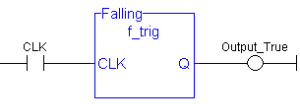![]()
 Function Block
Function Block![]() A function block groups an algorithm and a set of private data. It has inputs and outputs. - Falling pulse detection.
A function block groups an algorithm and a set of private data. It has inputs and outputs. - Falling pulse detection.
Inputs
|
Input |
Data Type |
Range |
Unit |
Default |
Description |
|---|---|---|---|---|---|
|
CLK |
BOOL |
|
|
|
Boolean signal. |
Outputs
|
Output |
Data Type |
Range |
Unit |
Description |
|---|---|---|---|---|
|
Q |
BOOL |
|
|
TRUE when the input changes from TRUE to FALSE. |
Truth Table
|
CLK |
CCLK (prev) |
Q |
|---|---|---|
|
0 |
0 |
0 |
|
0 |
1 |
1 |
|
1 |
0 |
0 |
|
1 |
1 |
0 |
Remarks
- It is recommended to use declared instances of R_TRIG or F_TRIG function blocks.
- This is to avoid contingencies during an Online Change
 Applies to downloading PLC code changes while the applicaiton is running..
Applies to downloading PLC code changes while the applicaiton is running..
- This is to avoid contingencies during an Online Change
FBD Language
FFLD Language
- In the FFLD language, ]P[ and ]N[ contacts can be used.
IL Language
(* MyTrigger is declared as an instance of F_TRIG function block *)
Op1: CAL MyTrigger (CLK)
LD"Ladder diagram" Ladder logic is a method of drawing electrical logic schematics. It is now a very popular graphical language for programming Programmable Logic Controllers (PLCs). It was originally invented to describe logic made from relays. The name is based on the observation that programs in this language resemble ladders, with two vertical "rails" and a series of horizontal "rungs" between them MyTrigger.Q
ST Q
ST Language
(* MyTrigger is declared as an instance of F_TRIG function block. *)
MyTrigger (CLK);
Q := MyTrigger.Q;
See Also








